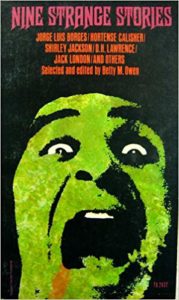Book Review: Nine Strange Stories edited by Betty N. Owen
When I was a lad, one of the fun annual events I looked forward to was the Scholastic Book Fair. Scholastic Publishing would send boxes of books around the country to schools so that kids could get the thrill of picking out their own low-cost volumes. Many of these, of course, were reprints of classics or what had been a bestseller in the children or young adult category a couple of years before. But a few were unique to Scholastic.
Thus it is with this collection of..wait for it…nine creepy tales. A bit surprisingly, this 1974 volume isn’t all public domain stories, but has a wider time range, from the beginning of the Twentieth Century to the 1960s. One gets the impression the editor picked from some of her favorites.
“The Rocking-Horse Winner” by D.H. Lawrence leads off with the sad story of a boy who can predict the winners of horse races by riding his rocking-horse and concentrating very hard. The driving personality of the tale is the boy’s mother, who has first-world problems. Born into the upper crust, she’s become a wife and mother out of obligation and inertia, because that’s what women of her social class did. Her husband is…disappointing…and his career stalls out at the bottom rungs, and she sees her children more as burdens than joys.
It’s pretty obvious that everyone would be happier if the family lived within their means, but the mother insists on the upper-class way of life, so there is always a need for “more money.” The son picks up on this, and in an effort to please his mother without letting her know he’s the one doing it, convinces his uncle and one of the servants to help him bet on horse races using the boy’s uncanny ability to pick winners.
Turns out that even with a supernatural edge, horse races aren’t that easy to predict, and there is a toll to be paid. Some might find the ending a bit heavy-handed.
“Heartburn” by Hortense Calisher involves a neurologist whose latest patient believes he has a small animal lodged in his chest. The condition may be psychosomatic, but that doesn’t mean it isn’t contagious….
“The Snail-Watcher” by Patricia Highsmith is about a man who becomes fascinated with the sex lives of snails. This seems an odd choice for a book aimed at junior high school students, but hey, they have to learn about the dangers of unprotected snail sex somewhere.
“Manuscript Found in a Police State” by Brian Aldiss centers around a unique concept for a prison, in which the prisoners themselves must drive themselves deeper into a mountain to have a hope of ever being released. The main character is a political prisoner who slowly realizes various things about the prison and conceives a plan to if not escape then at least make his imprisonment less onerous. It ends ambiguously as he takes the next step in his journey.
“The Man Who Sold Rope to the Gnoles” by Idris Seabright falls more into the category of dark fantasy. A salesman with more moxie than sense decides that the reclusive critters of the title are a good prospect for his products. He’s not wrong, per se. It’s just that he really should have found out more about their culture before closing the deal.
“The Mark of the Beast” by Rudyard Kipling, like many of his stories, is set in India. A drunken Englishman defiles the temple of Hanuman. A leper curses him with what is pretty obviously lycanthropy (in the old sense of believing one is a wolf.) Content warning: torture, just off screen. (“This part is not to be printed.”) The odor of colonialism also wafts from this story.
“The Summer People” by Shirley Jackson is a bit more vague as to setting, somewhere remote in New England. The Allisons have summered at their cottage there many years, always leaving promptly the day after Labor Day. But their children are grown, and there’s no pressing business back in the city. Why not stay a couple of extra weeks this year? The locals are surprised. None of the summer people ever stay into autumn. Never.
As the Allisons’ support systems fail one by one, they begin to realize just how isolated they are. Now, they wait, but for what?
“The Leopard Man’s Story” by Jack London is darkly humorous, about love and revenge in the circus. The title is a bit misleading, as the leopard man is the narrator, not the protagonist.
“The Garden of Forking Paths” by Jose Luis Borges finishes out the volume with the tale of a Japanese spy during World War One. Pursued closely by British spycatchers, the spy must somehow complete his mission–but then why has he gone to a seemingly random village to meet a harmless collector? But it is not so random, as the spy learns he has a very personal connection with the place he’s come to.
This book is a nice enough collection, but long out of print. You might be able to find a copy by haunting garage sales and school library discard events. Most of these stories can easily be found in other collections, and that might be your better bet. (I most recommend “The Summer People” and “The Snail-Watcher.”)
And now, the movie version of “The Rocking Horse Winner” from 1949!
https://www.youtube.com/watch?v=KqG19zEKQ-g&t=120s

